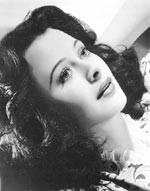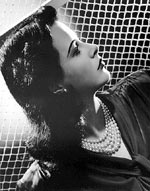

This Popular Culture item also falls into one of our favourite categories here at Shebang: UNLIKELY CONNECTIONS
Hedy Lamarr, Inventor of Frequency Hopping, now called Spread Spectrum Communication
Hedy Lamarr's name still ranks among the brightest lights in the history of movies. She also invented a communication system that was way ahead of its time, and is regarded by some as a 'stroke of genius'. It was originally conceived as a missile guidance system, but high-tech versions of that original concept - which now goes by the name of "spread spectrum" - have been used in military radios, wireless computer links and some cordless phones. Hedy Lamarr, clearly, was not just Another Pretty Face. Spread spectrum technology has revolutionized world-wide communications, and the possibilities are endless.
Hedy Lamarr, was born in Austria in 1913 - although she always gave the date as 1914 - and died this year, in January 2000 in Florida, U.S.A. She was often hailed as the world's most beautiful woman, and is probably still best known for her steamy appearance in the Czech-German film 'Ecstasy' ('Extase'). In what is thought to be the first nude scene in cinematic history, she frolicked and swam naked during a 10-minute sequence. It was immensely shocking at that time - 1933. In 1941 that she had the idea which added lustre to her remarkable life story. She had been able to build up her technical knowledge because after the scandal of 'Ecstasy' she gave up acting for a while and married an arms manufacturer by the name of Fritz Mandl. She quickly grew to hate Mandl, who turned her into a kind of slave, forcing her to sit by his side during dinner parties with high-ranking Nazi officers. But listening in on these technical conversations turned out to be a sophisticated technological education; she began thinking about using radio waves to guide missiles, but did not pursue the idea at that stage, since she realised that radio waves could be jammed, which would affect the missile's path.
She loathed Mandl's Nazi sympathies, and hated his possessiveness; by 1937 he was keeping her under constant surveillance. In desperation she drugged her maid, managed to escape and travelled to Hollywood, where Louis B. Meyer was delighted to sign her for MGM. It was then that she changed her name from Eva Marie Kiesler Mandl to Hedy Lamarr, apparently inspired by a great screen beauty called Barbara La Marr. A succession of leading romantic roles came her way - she was even first choice for the Ingrid Bergman part in 'Casablanca'. She was disparaging about her movie stardom, though. "Any girl can be glamorous," she once said. "All you have to do is stand still and look stupid." But not until recently has it been understood quite how intelligent she was. In 1941 at a Hollywood gathering - some kind of dinner party, apparently - she was trying to talk with the composer George Antheil. The room was extremely noisy, though. Lamarr rather jokingly suggested that they sing to each other. When they sang, their voices hopping from one note to another, their words became much clearer. This was the breakthrough Lamarr had been looking for when she first began wondering about guided missiles. If radio communication to missiles kept changing repeatedly and unpredictably, it should be impossible to jam them. They called this rapid process of change 'frequency hopping'.
George Antheil was something of an avante garde composer, one of the first respected musical artists to use the 'player piano', or 'pianola', a mechanical piano which played tunes without any human fingers touching the keys. George Antheil was excited by the fact that player pianos could play faster than any human possibly could and with several synchronized player pianos he could push the limits of music.
When George and Hedy Lamarr were brainstorming their invention, he immediately came up with the idea to use the same sort of cards as were used by 'player pianos' to create the required frequency hopping. Two paper piano rolls perforated with exactly the same patterns would be installed: one in the submarine transmitter and one in the torpedo receiver. Signals broadcast by the transmitter via quickly changing frequencies were always recognized by the receiver, which was simultaneously changing to the identical frequency, according to the identical pattern of slots. Just as changed and held notes make a melody, their invention held and changed radio frequencies to make an unbreakable code. They hoped that this invention would protect U.S. radio-guided torpedoes from Nazi interception because an enemy could neither deflect the torpedo by fake transmissions nor jam it.
Lamarr and Antheil received Patent No. 2,292,387 for their invention, but Antheil later confessed that they didn't handle the military well. They had hoped to simplify their explanation by saying the fundamental mechanism was the same as a player piano, but ' the reverend and brass-headed gentlemen in Washington' were not altogether prepared to put a pianola in a torpedo.
Hedy Lamarr's married and divorced five times. (She never married Antheil, they were just good friends) She was often short of money, and in her time faced accusations of insurance fraud, false rape and shoplifting. Her movie career ended in 1958. At about the same time the patent ran out on the frequency hopping idea. Patents in the U.S. at that time ran for 17 years.
As soon as the time was up, the government hired engineers to make the patent feasible. That was when it became known as spread spectrum technology. It was first used in a military context in 1962 during the Cuban Missile crisis, and was actively used in the Gulf during the 1990's The technology is already being utilised in more than forty devices, including for Cellular phones, Pagers, Wireless Internet systems, Garage door opener, Traffic signals, fax machines and Cordless phones Adapted to use today's ultrafast microprocessors- is coming into it's own as an effective and inexpensive way to communicate over long distances, privately efficiently. It is offering an alternative way for schools in the most remote and poorest areas to be connected to the Internet with no telephone charges.
Not long before she died, Hedy Lamarr herself - who had begun to win award after award for her invention - said "It is gratifying to see how an idea born more than 50 years ago during wartime is being used today to help people communicate in countries around the world."




Note
In 1977, only 2.2% of all patents were held by
women. In 1988, statistics indicate that women held about 5.6% of all
patents.